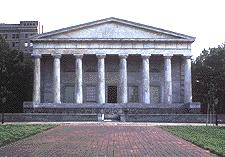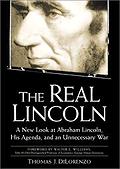The federal government today can wage wars without the consent of our congressional representatives, overthrow foreign governments, tax nearly half of national income, abolish civil liberty in the name of "homeland security" and "the war on drugs," legalize and endorse infanticide ("partial-birth abortion"), regulate nearly every aspect of our existence, and there’s little or nothing we can do about it. "Write your congressman" is the refrain of the slave to the state who doesn’t even realize he’s a slave (thanks to decades of government school brainwashing).
 But Americans were not always slaves to federal tyranny. Perhaps the best illustration of this is how Americans once utilized the Jeffersonian, states’ rights traditions of nullification and interposition to assist President Andrew Jackson in his campaign to veto the re-chartering of the Second Bank of the United States (BUS) in 1832. Jackson essentially ended central banking in America until it was revived thirty years later by the Lincoln administration. The story is told in James J. Kilpatrick’s wonderful 1957 book, The Sovereign States: Notes of a Citizen of Virginia.
But Americans were not always slaves to federal tyranny. Perhaps the best illustration of this is how Americans once utilized the Jeffersonian, states’ rights traditions of nullification and interposition to assist President Andrew Jackson in his campaign to veto the re-chartering of the Second Bank of the United States (BUS) in 1832. Jackson essentially ended central banking in America until it was revived thirty years later by the Lincoln administration. The story is told in James J. Kilpatrick’s wonderful 1957 book, The Sovereign States: Notes of a Citizen of Virginia.
The Bank was notorious for fraud, mismanagement, corruption, and attempts to engineer a "political business cycle." Prior to 1861, the American people were still sovereign over their government. They exercised that sovereignty in the way the founders intended: through state political conventions or legislatures. The federal government was their agent.
Consequently, as early as 1816, Indiana and Illinois amended their state constitutions to prohibit the BUS from establishing branches within their jurisdictions. North Carolina, Georgia, and Maryland imposed heavy taxes on BUS branches within their states in attempts to tax them out of existence (A tax that even libertarians could love!). Knowing that such taxes could destroy the central bank, the federal government brought suit in Maryland (McCulloch vs. Maryland), confident that John Marshall, chief justice of the Supreme Court and a proponent of the BUS, would rule in its favor. He did, coining the famous phrase that "the power to tax involves the power to destroy" in his decision. He wasn’t expressing a fear that taxation could destroy private initiative and private enterprise, but that it could limit the federal government’s monetary monopoly.
 Despite Marshall’s opinion that state taxes on the BUS were unconstitutional, numerous states continued to harass the bank. Until 1865, the Supreme Court’s opinion was just the Supreme Court’s opinion. The citizens of the states reserved the right to offer their own opinions on constitutionality, which they often considered to be every bit as valid as the Court’s. The same was true of certain presidents: Andrew Jackson essentially said "thank you for your opinion" and then thumbed his nose at the Court when it ruled that the BUS was constitutional.
Despite Marshall’s opinion that state taxes on the BUS were unconstitutional, numerous states continued to harass the bank. Until 1865, the Supreme Court’s opinion was just the Supreme Court’s opinion. The citizens of the states reserved the right to offer their own opinions on constitutionality, which they often considered to be every bit as valid as the Court’s. The same was true of certain presidents: Andrew Jackson essentially said "thank you for your opinion" and then thumbed his nose at the Court when it ruled that the BUS was constitutional.
After Marshall’s 1819 opinion, Ohio enacted a $50,000 per year tax on the BUS. The Bank refused to pay, so the Ohio state auditor ordered a deputy, one John L. Harper, to collect the tax. As Kilpatrick (p. 151) explains it:
[O]n the morning of September 17, Harper made one last request for voluntary payment. When this was denied, he leaped over the counter, strode into the bank vaults, and helped himself to $100,000 in paper and specie. He then turned this over to a deputy . . . stuffing this considerable hoard into a small trunk, with which the party thoughtfully had come equipped . . .
This would be the equivalent of today’s governor of Ohio ordering state troopers to enter the Cleveland Fed and strip its vaults of over a million dollars. The BUS sued Ohio, relying on Marshall’s opinion. The Ohio legislature considered such a lawsuit to be a threat to citizen sovereignty and a dangerous precedent to all Americans, not just Ohioans. It issued a statement saying, "To acquiesce in such an encroachment upon the privileges and authority of the States, without an effort to defend them, would be an act of treachery to the State itself, and to all the States that compose the American Union (emphasis added)."
The legislature stated that it was aware of the theory that the Supreme Court is to be the interpreter of the Constitution, but declared that "to this doctrine . . . they can never give their assent" (Kilpatrick, p. 152). The legislature quoted Jefferson’s Kentucky Resolve of 1798, which said that "as in all other cases of compact among parties having no common judge," each party "has an equal right to interpret the Constitution for themselves, where their sovereign rights are involved . . ."
Marshall was wrong, the Ohioans said, because his opinion unconstitutionally encroached upon the sovereignty of the states. Therefore, they were under no obligation to acquiesce in his ruling.
The Ohio legislature promised to return the $100,000 if the BUS left the state. If not, it proposed a law forbidding "the keepers of our jails" from imprisoning any person "committed at the suit of the Bank of the United States"; prohibiting Ohio courts from "taking acknowledgements of conveyance where the Bank is a party"; and forbidding "our courts, justices of peace, judges and grand juries from taking any cognizance of any wrong alleged to have been committed upon any species of property owned by the Bank." Invoking Jefferson’s "Doctrine of ’98," the Ohioans concluded by "denouncing the Federal courts for violation of the Constitution" (p. 154).
The BUS persisted in its lawsuit, and eventually had the state treasurer arrested and imprisoned. While in prison, the keys to the state vaults were physically taken from him and the feds took back the $100,000, apparently still in the same trunk.
This act infuriated the Ohioans even more, and they continued to harass the Bank, as did many other states. Kentucky and Connecticut adopted Ohio’s states’ rights stand toward the Bank in 1825. In 1829, South Carolina imposed a tax on stockholders of the Bank within the state. New York and New Hampshire enacted resolutions urging that the Bank not be re-chartered. As Kilpatrick concludes:
In the face of this unrelenting warfare, the bank could not survive. Withdrawal of the public deposits began in August of 1833, under Jackson’s order; and when Pennsylvania governor Wolf, who had been one of the bank’s staunchest supporters, denounced the institution in . . . March of 1834, public opinion was fatally influenced against the bank. The Pennsylvania Senate adopted fresh resolutions urging that the bank ought not to be re-chartered. The following month, the United States House of Representatives adopted the same view, and the bank’s days came to an end (p. 157).
Andrew Jackson is usually given credit for (temporarily) ending central banking in America in the nineteenth century. But he had help. It was this expression of citizen sovereignty, in the spirit of the Jeffersonian states’ rights tradition, that made Jackson’s veto of the bank politically possible.
States’ rights as a check on the tyrannical proclivities of the central government ended in 1865, of course. As Forrest McDonald noted in States’ Rights and the Union (p. 224), after Lincoln’s war the Supreme Court "became the sole and final arbiter of constitutional controversies. No longer could a Jefferson arise to insist that the other branches of the federal government had coequal authority to determine constitutionality. No more could a Calhoun arise to defend a doctrine of interposition or nullification."
 The imperious Woodrow Wilson would celebrate this fact in his 1908 book, Constitutional Government in the United States, where he wrote (p. 178) that "the War between the States established . . . this principle, that the federal government is, through its courts, the final judge of its own powers."
The imperious Woodrow Wilson would celebrate this fact in his 1908 book, Constitutional Government in the United States, where he wrote (p. 178) that "the War between the States established . . . this principle, that the federal government is, through its courts, the final judge of its own powers."
 In A View of the Constitution, published a century earlier, the Jeffersonian legal scholar St. George Tucker cited this phenomenon as the very definition of tyranny. If the federal government ever became the final judge of the limits of its own powers, Tucker warned, then constitutional liberty would become an empty phrase. The federal government would inevitably conclude that there are, in fact, no limits to its power.
In A View of the Constitution, published a century earlier, the Jeffersonian legal scholar St. George Tucker cited this phenomenon as the very definition of tyranny. If the federal government ever became the final judge of the limits of its own powers, Tucker warned, then constitutional liberty would become an empty phrase. The federal government would inevitably conclude that there are, in fact, no limits to its power.
Really Learn About the Real Lincoln Now there is a study guide and video to accompany Professor DiLorenzo’s great work, for homeschoolers and indeed anyone interested in real American history. http://www.fvp.info/reallincolnlr/




